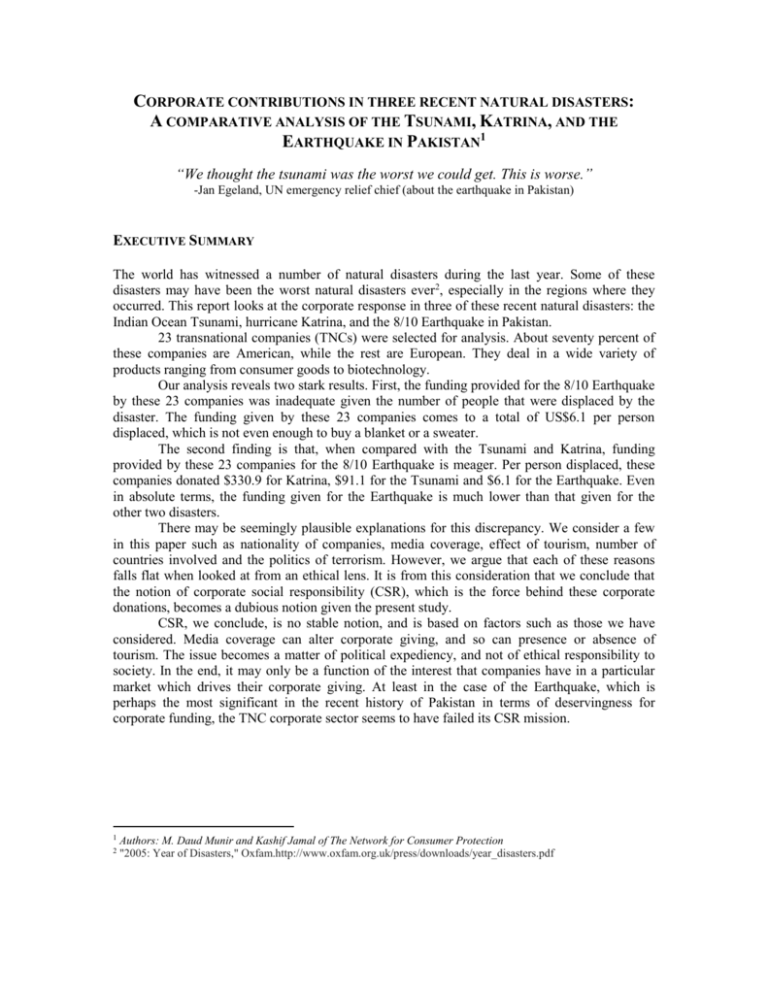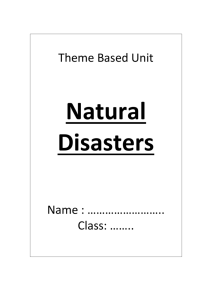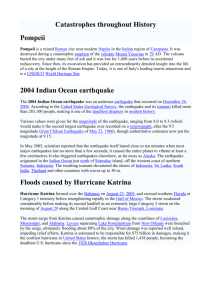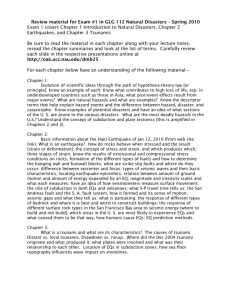doc - Eldis
advertisement

CORPORATE CONTRIBUTIONS IN THREE RECENT NATURAL DISASTERS: A COMPARATIVE ANALYSIS OF THE TSUNAMI, KATRINA, AND THE EARTHQUAKE IN PAKISTAN1 “We thought the tsunami was the worst we could get. This is worse.” -Jan Egeland, UN emergency relief chief (about the earthquake in Pakistan) EXECUTIVE SUMMARY The world has witnessed a number of natural disasters during the last year. Some of these disasters may have been the worst natural disasters ever2, especially in the regions where they occurred. This report looks at the corporate response in three of these recent natural disasters: the Indian Ocean Tsunami, hurricane Katrina, and the 8/10 Earthquake in Pakistan. 23 transnational companies (TNCs) were selected for analysis. About seventy percent of these companies are American, while the rest are European. They deal in a wide variety of products ranging from consumer goods to biotechnology. Our analysis reveals two stark results. First, the funding provided for the 8/10 Earthquake by these 23 companies was inadequate given the number of people that were displaced by the disaster. The funding given by these 23 companies comes to a total of US$6.1 per person displaced, which is not even enough to buy a blanket or a sweater. The second finding is that, when compared with the Tsunami and Katrina, funding provided by these 23 companies for the 8/10 Earthquake is meager. Per person displaced, these companies donated $330.9 for Katrina, $91.1 for the Tsunami and $6.1 for the Earthquake. Even in absolute terms, the funding given for the Earthquake is much lower than that given for the other two disasters. There may be seemingly plausible explanations for this discrepancy. We consider a few in this paper such as nationality of companies, media coverage, effect of tourism, number of countries involved and the politics of terrorism. However, we argue that each of these reasons falls flat when looked at from an ethical lens. It is from this consideration that we conclude that the notion of corporate social responsibility (CSR), which is the force behind these corporate donations, becomes a dubious notion given the present study. CSR, we conclude, is no stable notion, and is based on factors such as those we have considered. Media coverage can alter corporate giving, and so can presence or absence of tourism. The issue becomes a matter of political expediency, and not of ethical responsibility to society. In the end, it may only be a function of the interest that companies have in a particular market which drives their corporate giving. At least in the case of the Earthquake, which is perhaps the most significant in the recent history of Pakistan in terms of deservingness for corporate funding, the TNC corporate sector seems to have failed its CSR mission. 1 2 Authors: M. Daud Munir and Kashif Jamal of The Network for Consumer Protection "2005: Year of Disasters," Oxfam.http://www.oxfam.org.uk/press/downloads/year_disasters.pdf 1. INTRODUCTION A few things differentiate the responsiveness of present-day natural disasters from those which happened two or three decades ago. Two of these directly contribute to the ‘globalization of response’ to natural disasters. These two changes – increased transnational corporate activity and development of mass media – change considerably the way that natural disasters are responded to. It would be worthwhile then, at the outset, to consider these two changes: Transnational Corporate Activity There are presently thousands of companies which do business in one form or another inside countries other than their home country. Table 1. Market values and GDPs of The biggest of these have market values greater selected countries and companies Market Value/ than the GDPs of many countries (see table 1). Country / Company GDP These global companies exercise immense ($Mil) influence in the countries where they manufacture 273750 or sell their products. Important to understand for Microsoft Citigroup 247660 the purpose of the present report is the notion of RD/ Shell Group 221490 corporate social responsibility (CSR). CSR is a Pfizer 197990 broad term, with adherents and opponents with Procter & Gamble 133920 varying perspectives. Essentially, its adherents Malaysia 118300 claim that corporations are morally responsible Pakistan 96100 entities and can not only effectively regulate their Egypt 75100 own activities to a large extent, but can also Peru 68600 further the cause of social justice and en- Mali 4900 vironmental protection. Its opponents claim that Sources: Forbes website (www.forbes.com) & Bank at a glance country reports ( CSR is a false notion3. To them, it can mean World http://devdata.worldbank.org/edstats/cg.asp) 4 anything from an advertising tactic to a tacit (accessed 21-11-05) attempt to reduce the level of governmental regulation on their activities, as well as reduce welfare spending. Whatever the case, it is now true that most global corporations consider themselves to be socially responsible. Effect of Mass Media The information and communication revolution has meant that news of events even in remote areas of the world is immediately communicated to those who have access to the information resources (television, internet, radio etc.). As people watch live footage of events from distant places in the world, they feel in some way or another connected to the events, and indeed to the people involved in those events. Especially in case of natural disasters, when images of death and deprivation are viewed by people, they feel somehow responsible to help those in need. 3 4 Henderson, D. "The case against 'Corporate Social Responsibility'", Policy, Winter2001,Vol. 17, Issue 2 Coors, A. and Winegarden, W., "Corporate Social Responsibility or good advertising", Regulation, Spring 2005 2. THE 3 DISASTERS In this report we will compare corporate aid in three natural disasters that took place in 2004-05. The details of these disasters are as follows (see table 2 for data on casualties and displaced population): The Indian Ocean Tsunami On 26 December 2004, a massive earthquake off the island of Sumatra in Indonesia generated tsunamis that caused massive destruction in the coastal areas of South-East Asia, reaching even as far as East Africa. The countries most affected were Indonesia, Sri Lanka, India, Thailand and Maldives. Hurricane Katrina Thought to be the most destructive (and costliest) natural disaster in the history of the US, Hurricane Katrina made its landfall twice on continental United States. On 29 August 2005, Katrina made landfall on the southern state of Louisiana causing extensive destruction. It continued to cause damage in Mississippi and Alabama. Earthquake (Pakistan) On October 8 2005, a powerful earthquake measuring 7.6 on the Richter scale struck South Asia. Its epicenter was located about 90 kilometers north-east of Islamabad. Affecting mostly mountainous areas of Abbottabad, Batagram, Mansehra and Kohistan in NWFP and Neelum, Bagh, Punch and Muzaffarabad in Azad Kashmir. Table 2. Dead and displaced in the Tsunami, Katrina and the Earthquake (Pakistan) Natural Disaster Indian Ocean Tsunami Hurricane Katrina Earthquake (Pakistan) Casualties 170,000 1033 73,276 Population displaced (millions) 1.5 0.3 3.2 Sources: WHO Situation Report 24 for Tsunami5, OCHA Situation Report 19 for Earthquake6 & LAFD Situation Report September 7, 2005 for Katrina7 5 http://www.who.int/hac/crises/international/asia_tsunami/sitrep/24/en/index.html http://ochaonline.un.org/DocView.asp?DocID=3951 7 http://www.laafricanamericankatrinaresource.net/Submissions/KatrinaSitRept09-07-05TTG.pdf 6 3. THE 23 COMPANIES In the current analysis we selected 23 corporations that were major donors in the 8/10 earthquake8. Data was then obtained for the corporate donations made by these companies in the other two natural disasters (for data sources, please see Appendix). By location of headquarter, 15 companies are American, 3 German, 2 Anglo-Dutch, 1 French, 1 British and 1 Finnish. Sector-wise 6 deal in consumer goods, 5 in pharmaceuticals, 3 in telecommunication, 2 in information technology, 2 in energy, 2 in finance and banking, 1 in technology, 1 in biotechnology, and 1 in chemicals. Table 3 shows corporate donations in the three natural disasters. Corporate aid shown in these tables is an aggregate of both cash and in-kind donations. Table 3. Corporate donations in the three disasters # Company 1 2 3 4 5 6 7 8 9 10 11 12 13 14 15 16 17 18 19 20 21 22 23 Pfizer Citigroup Coca Cola Pepsi Cola Unilever Intel MERCK Bayer Siemens Motorola Shell GSK Procter & Gamble Monsanto Wyeth Johnson & Johnson Microsoft Nokia Chevron-Caltex BASF Alcatel American Express Kodak Total Earthquake total Tsunami total Katrina total (Million USD) (Million USD) (Million USD) 6.11 3.0 2.03 2.0 1.16 1.0 0.67 0.55 0.52 0.5 0.5 0.33 0.5 0.25 0.18 0.15 0.13 0.12 0.05 0.016 0.016 0.015 0.001 35.0 7.4 19.8 2.0 7.47 1.0 10.4 15.2 1.17 3.8 3.1 2.34 2.0 1.3 1.0 2.0 3.5 3.51 12.0 4.9 1.0 1.0 1.5 6.0 11.2 5.0 2.1 3.6 1.0 11.8 2.0 2.0 1.5 3.0 10.0 10.0 1.0 1.0 9.4 9.0 1.0 5.0 1.0 1.17 1.0 0.5 19.79 142.39 99.27 Sources: See Appendix 8 It is important to note that there were Pakistani companies that donated significantly more than many of the companies selected for the current analysis. However, this analysis is focused on transnational corporations only. 4. COMPARISON OF CORPORATE GIVING There is considerable variation in the corporate aid given out by the selected 23 global companies in the three disasters. The most funding was provided for the Indian Ocean Tsunami (142.39 million dollars), followed by the hurricane Katrina (99.27 million dollars). The least funding was given for the earthquake in Pakistan (19.79 million dollars) (see table 3). These figures would become more intelligible against the backdrop of the damage caused by each disaster. There are several conceivable ways to compare the three disasters including death toll, number of injured, number of displaced etc. The most suitable indicator for the damage, however, seems to be the number of displaced people. This is because the funding is going to be targeted at this subset of the population. Those who have perished in the disaster also need assistance (for instance for proper burial). But, most of the funding is going to be used for the relief and rehabilitation of the displaced people. It seems right, then, to compare the funding in light of the number of people displaced in each disaster (see table 4, and figures 1, 2 & 3). Table 4. Comparison of corporate giving in the three disasters by dollars per person displaced Natural Disaster Earthquake (Pakistan) Indian Ocean Tsunami Hurricane Katrina Total funding by the 23 companies (Million US$) 19.79 142.39 99.27 Population displaced (Millions) Dollars per person displaced 3.2 1.5 0.3 6.1 91.1 330.9 Sources: see tables 2 & 3 Fig. 1 Population Displaced Fig 2. Corporate donations by the 23 companies 3.5 160 3 140 120 Million US$ Millions 2.5 2 1.5 100 80 60 1 40 0.5 20 0 0 Earthquake Tsunami Katrina Earthquake Tsunami Katrina $ $ $6.1 $91.1 $330.9 per person displaced per person displaced per person displaced EARTHQUAKE PAKISTAN INDIAN OCEAN TSUNAMI HURRICANE KATRINA Figure 3. Dollars per person displaced in Earthquake (Pakistan), Indian Ocean Tsunami, Hurricane Katrina 5. ANALYSIS OF CORPORATE GIVING As can be seen from table 4 and figures 1, 2 & 3, funding for Katrina per person displaced far exceeds the funding for Tsunami. Most relevant, however, for the current analysis is the fact that the funding for the 8/10 Earthquake is negligible compared to that for Katrina and the Tsunami. The response in case of the Earthquake has certainly been inadequate (see box 1). Add to that various losses and leakages, the actual money that would reach the affected from these 23 companies would be seriously insufficient. The question that arises from this analysis is why funding in the case of the earthquake in Pakistan was so niggardly compared to the other two disaster. A variety of explanations are possible: 9 Nationality of companies It can be argued that since 15 out of 23 of the companies are American, therefore they contributed much more to the disaster in America. However, this reasoning, in our opinion, is not ethically sound. Just like the unethical 10/90 gap9 in which 90 per cent of the money in research and development in health is spent on finding cures for diseases that affect 10 per cent of the population, this ‘ownership effect’ is not enough to hold back aid. All these companies do, in fact, draw out profits from Pakistan. Shell, for instance, declared 2451 million rupees in profits in Pakistan10. Their corporate aid in the 8/10 earthquake (30 million rupees) was negligible compared to the profits they made. Box 1. What’s $6.1 good for? Per person funding provided by 23 transnational companies, some of which are richer than countries, to those displaced in the earthquake would be good enough for purchasing: 1/14 of a cheaply priced tent, or 1/3 of a cheaply priced blanket, or 1/2 of a cheaply priced sweater Media coverage Media coverage given to the three disasters varied considerably in the West. It is understandable – to some extent – that the coverage given to Katrina should have exceeded coverage given to the other two disasters in the United States. But, it seems that the coverage given to the earthquake was considerably lower than the other two disasters. In table 5 we have given details from two publications: the Economist (UK) and New York Times (US). To make a fair comparison, we have compared coverage of the three disasters for 40 days after each disaster. http://www.msf.org/msfinternational/invoke.cfm?objectid=A56D1BCD-7191-4AF5-91EBAED01A756D51 &component =toolkit.article&method=full_html 10 http://www.shell.com/static/pk-en/downloads/about_shell/financial_reports_2005/annual_report_2005.pdf Media coverage affects responsiveness in disasters in several ways. First, given the notion of CSR, companies are better motivated to give funding, and then ‘advertise’ it to those who buy their products. The more ‘important’ an event is in the eyes of the consumers and citizens, the more funding that event will get in this way. Second, given that providing aid has an opportunity cost, citizens of other countries do not feel deprived of funding that could have been used on them instead. For instance, many Americans think that the aid the US government gives to developing countries is too much. However, it is a fact that US gives the least funding as percentage of its GDP amongst the rich countries. Table 5. Media coverage in the West of the three disasters Disaster Earthquake (Pakistan) Indian Ocean Tsunami Hurricane Katrina Economist (UK) New York Times (US) (Articles that mention the disaster till forty days after it occurred) (Articles that mention the disaster till forty days after it occurred) 12 23 41 82 421 1268 Sources: New York Times websites (www.nytimes.com) & The Economist website (www.economist.com) (both accessed 21-11-05). Note: Those articles which were only marginally related to each event were not included Effect of tourism One of the possible reasons as to why the response in case of Tsunami was much better could be that the countries where the disaster happened were mostly tourist countries. In fact, a few hundred European and American tourists actually died in the disaster. Pakistan, however, especially after 9/11 is a not an important tourist destination. Very few people of nationalities other than Pakistan died in the earthquake. Given the heightened nature of nationalism in modern times, people feel responsible towards their own people more than they do to those of other countries. However, as the importance of the event grew, the countries where the foreign tourists died stood to benefit as well. Size of Market Another reason for the greater response in the US and some of the Tsunami affected countries could have been the greater sizes of the markets in these countries, including larger consumer bases. The US is certainly the richest country in the world, and consumption is a key driving force in its economy. The Tsunami involved countries such as India and Indonesia, which together have about eight times the number of people that Pakistan has. Given these facts, one can see the pragmatism on part of the companies in releasing a larger share of their corporate donations to the Tsunami and Katrina, while reserving only a niggardly share for a country where they expect to extract little anyway. This argument makes good business sense. But, ethically, it stands little chance for acceptability. If the companies are operating in all of these countries, and the driving force behind their donation is ‘humanitarian relief’, then how did some humans come to count less than other humans in countries with ‘better markets’? If that is the case, then the agenda for humanitarian relief and other social improvement causes must simply be taken away from the companies, and be handed over to more reliable and fair global institutions. The number of countries involved The sheer geographical scope of the tsunami was so immense that it affected people in as many as ten countries. Although the number of people displaced were far greater in the 8/10 earthquake, the number of countries affected were so many more in case of the Tsunami. More countries means more diplomatic ties, more well-settled diaspora in the rich countries, and more country offices of various transnational corporations. The politics of terrorism Pakistan has, over the last few years, been associated much with the rise of terrorism. Whether as friend or foe, this association means that the only coverage many in the West have seen of Pakistan is in conjunction with terrorism. This misrepresentation has the effect of dehumanizing a whole people, and one ramification of this can certainly be the niggardly amount given to those affected in Pakistan. ‘Donor fatigue’ One reason that is often cited for both the lateness of response and the frugal giving in case of the 8/10 Earthquake is ‘donor fatigue’. According to this argument, the timing of these three major disasters in a span of ten months fatigued the donors, such that they couldn’t ‘afford’ to help properly anymore. Therefore, when the Tsumani struck, they had much of their corporate donation money lying around, but later the amount had dwindled to naught. This is an interesting argument and may be satisfactory to all except those who stood to lose almost everything in the disasters. Human being in distress need aid – not arguments. That money was provided by a company in an earlier disaster is no consolation for someone who has lost his shelter in freezing weather. If the phenomenon of donor fatigue really exists for companies who have market values far greater than the GDPs of scores of countries, then they had better plan better or reevaluate their humanitarian agenda. In this paper, however, we contend that the other factors are much stronger than the timing factor. This is because for the magnitude of damage (in terms of lives lost and people displaced) these companies were able to donate extravagantly in Katrina, just a few months after the Tsunami. We wonder why it is especially in case of a smaller market with fewer consumers and little tourist attraction where the money ran out. 5. CONCLUSION We have considered seven seemingly plausible explanations for the discrepancy in corporate giving in the 8/10 disaster versus the other two disasters. And, as explained, none of these explanations offer any satisfying reasons for the insufficiency of corporate giving in the Earthquake. Instead they make us aware of holes in the arena of international politics as it relates to media and business, such that people in some parts of the world become better represented, and in turn, seem to have greater worth than those in other parts of the world. The notion that concerns us most in this study, however, is that of corporate social responsibility (CSR). It is from the framework of this notion that companies, whose explicit aim is profit-making, come forward and donate millions of dollars for improving the lives of people living in the societies where they do business. The companies, and the academics who support the notion, argue that many companies have become so influential that they can best further the cause of societal improvement. The critics, however, think that this would only lead to a relaxation in governmental regulation11. The present study reveals some interesting findings with regard to the CSR debate in Pakistan. We contend that the 8/10 earthquake was the most worthy event for corporate funding under the CSR notion in at least a couple of decades in Pakistan (or ever, it may be argued). But, the response has been less than encouraging. Our analysis reveals that CSR is no stable notion, and that the donations to society under this notion are no security to its people. It is impossible to question the companies on the amount they donate. Moreover, the donations given depend on such external (and often political) factors such as media coverage, presence of tourism, and number of nature of consumers etc. that it is very unfit to replace a sound and stable governmental responsibility towards citizens. Eventually, CSR giving may only reflect business expediency on part of the company, such that its responsibility may be directly proportional to the amount of profit it makes from a population. Where there are actual lives at stake, this form of economic aid for people in distress is highly questionable, and indeed, ethically unacceptable. For a useful introduction to the CSR debate, see ‘Corporate Social Responsibility’ a debate between Tom Burke and Joel Bakan, published in The Ecologist In March 2005 11 APPENDIX . SOURCES FOR TABLE 3 ‘Earthquake total’ column has been taken from the following website (except for ‘Procter & Gamble’): http://www.privatisation.gov.pk/Handout/HO-AR-05/Oct-05/HO28102005%20Cabinet%20Committee%20on%20Fund%20Raising%20From%20Business%20Community %20for%20Earthquake%20Relief-Rs.%208.4%20Billion%20Relief%20Mobilized.htm (Accessed November 11, 2005) Figures of Tsunami and Katrina have been obtained from the following websites, respectively (Accessed November 11, 2005): Pfizer: http://www.pfizer.com/pfizer/are/mn_tsunami_qa.jsp and http://www.pfizer.com/pfizer/are/news_releases/2005pr/mn_2005_0921a.jsp Citigroup: http://www.citibank.hu/hungary/homepage/others/szokoar_e.htm and http://www.citi.com/citigroup/press/2005/050907a.htm Coca Cola: http://www2.coca-cola.com/ourcompany/wn20050121_tsunami.html and http://www2.coca-cola.com/ourcompany/wn20050907_hurricane_katrina.html Pepsi Cola: http://www.pepsico.com/PEP_Citizenship/Contributions/FeaturePrograms/index.cfm Unilever: http://www.unilever.com/ourvalues/environmentandsociety/casestudies/environment/tsunami.asp and http://www.unileverusa.com/ourcompany/newsandmedia/pressreleases/Hurricane_Katrina.asp Intel: http://portland.bizjournals.com/portland/stories/2004/12/27/daily31.html and http://abcnews.go.com/Technology/HurricaneKatrina/story?id=1084342&page=1 MERCK: http://www.bio.org/news/features/20050111.asp and http://www.merck.com/about/feature_story/09022005_katrina.html Bayer: http://www.bayer.com/about-bayer/social-responsibility/donations/tsunami-catastrophe/page3251.htm and http://www.press.bayer.com/News/News.nsf/0/B143B5E1B5DEB0B7C125706F005344F9?Open&ccm=01 0005000&l=EN Siemens: http://www.siemens.com/index.jsp?sdc_p=t15cz3suo1237127pnflmi1237116&sdc_sid=1287710680& and http://www.usfilter.com/en/About+USFilter/Newsroom/siemens_katrina_release_091205.htm Motorola: http://www.motorola.com/content/0,,5199,00.html and http://www.motorola.com/mediacenter/news/detail/0,,5920_5882_23,00.html Shell: http://www.shell.ca/code/library/news/2004/04nr_dec31_tsunami.html and http://www.shell.com/home/Framework?siteId=us-en&FC2=/usen/html/iwgen/news_and_library/storm_updates/katrina/zzz_lhn.html&FC3=/usen/html/iwgen/news_and_library/storm_updates/katrina/storm_update_jdh_message3.html GSK: http://www.gsk.com/financial/reports/ar2004/annual-review-04/contributing.htm and http://www.gsk.com/ControllerServlet?appId=4&pageId=402&newsid=640 Procter & Gamble: (website accessed on November 23, 2005) http://www.pg.com/news_flash/earthquake_in_pakistan.jhtml (for 8/10 Earthquake), http://fdncenter.org/cleveland/gtmd/cl_gtmd_020105.html and http://www.pg.com/news_flash/dynamic_article.jhtml?document=%2Fcontent%2Fen_US%2Fxml%2Finfo _center%2Fpg_donations_update.xml Monsanto: http://www.bio.org/news/features/20050111.asp and http://www.monsanto.com/monsanto/layout/media/05/09-01-05.asp Wyeth: http://www.bio.org/news/features/20050111.asp and http://www.wyeth.com/news/Pressed_and_Released/pr09_01_2005_16_06_41.asp Johnson and Johnson: http://www.jnj.com/news/jnj_news/20050112_160450.htm and http://www.jnj.com/news/jnj_news/20050902_152838.htm Microsoft: http://www.microsoft.com/presspass/press/2005/jan05/0106TsunamiFS.mspx and http://www.microsoft.com/presspass/features/2005/sep05/09-09katrina.mspx Nokia: http://press.nokia.com/PR/200501/976823_5.html and http://www.nokiausa.com/about/newsroom/article/1,1046,3429,00.html Chevron- Caltex: http://www.chevron.com/news/current_issues/tsunami_additional_contribution.asp and http://www.chevron.com/news/press/2005/2005-08-30.asp BASF: http://www.basf.com/corporate/news2005/021105_tsunami.htm and http://www.basf.com/corporate/news2005/09-02-05_Katrina.htm Alcatel: http://www.alcatel.com/vpr/index.jhtml?body=http://www.home.alcatel.com/vpr/vpr.nsf/8b38f62746ee1dc ac12567a8004691d8/62f8d25afb94518dc1256f8500496c74!OpenDocument and http://www.alcatel.com/vpr/index.jhtml?body=http://www.home.alcatel.com/vpr/vpr.nsf/8b38f62746ee1dc ac12567a8004691d8/0b9eebda4adc7547c125707400352bc5!OpenDocument American Express: http://www10.americanexpress.com/sif/cda/page/0,1641,13556,00.asp and http://amex.justgive.org/katrina/ Kodak: http://www.letsgodigital.org/en/news/articles/story_2379.html and http://www.nema.org/media/ind/20050909b.cfm







